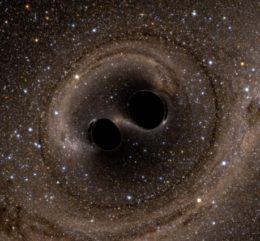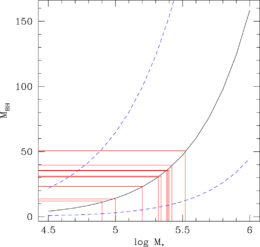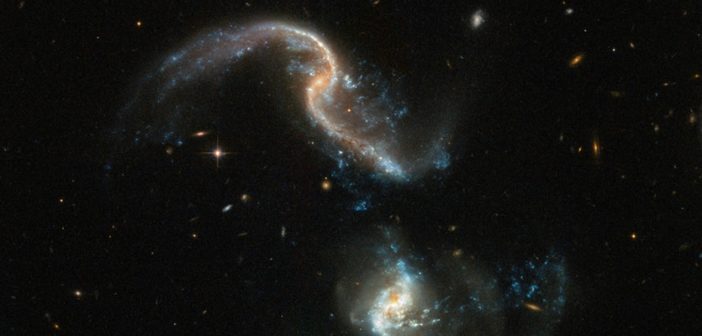Thanks to the Laser Interferometer Gravitational-wave Observatory (LIGO), we now know that black holes in our distant universe sometimes find each other in a dramatic inspiral and collision, releasing a burst of gravitational-wave emission that we can detect here on Earth.
But what happened earlier in these black holes’ lives to bring them to this point? A new study explores the possibility that LIGO’s black holes once lay at the centers of very small galaxies — until those galaxies collided.

Simulated image of two merging black holes, viewed face-on. LIGO has announced the detection of ten of these events so far. [SXS Lensing]
Central Lurkers
Since we discovered the first wiggles in spacetime signifying the distant merger of two black holes, LIGO has announced around ten confident detections of gravitational waves from black hole–black hole collisions — with the prospect of many more discoveries in the future.
But how did these black holes find each other? A team of scientists led by Christopher Conselice (University of Nottingham, UK) has proposed a picture that hinges on the central black holes we believe lie at the heart of most, if not all, galaxies.
The team proposes that very low-mass dwarf galaxies contain central black holes of less than 100 solar masses. The mergers of pairs of these tiny galaxies ultimately lead to the inspirals and mergers of their central black holes — possibly accounting for the majority of LIGO’s detections of black hole–black hole collisions.
Testing Feasibility
Conselice and collaborators test this scenario by breaking it down into multiple steps.

The relationship between black hole mass and host galaxy stellar mass (black solid line; blue dashed lines show uncertainties), extrapolated down to low masses. Red lines indicate the masses of LIGO-detected black holes. [Conselice et al. 2020]
- Can you get central black holes of the right mass?
We’ve observed a relationship between galaxy mass and central black hole mass. By extrapolating this relationship to low masses, we find that ultradwarf galaxies can have central black holes of less than 100 solar masses — consistent with the LIGO-observed black holes of 10–70 solar masses. - Will these ultradwarf galaxies merge frequently enough?
Mergers of galaxies occurred more frequently in the early universe than they do today. Cosmological models indicate that galaxies don’t merge frequently enough today to reproduce LIGO’s observations — but at a redshift of z ~ 1.5 or higher, ultradwarf galaxies could merge often enough to match LIGO-measured gravitational-wave event rates. - Will the black holes collide fast enough after the galaxies merge?
If the galaxies merged at a redshift of z > 1.5, the central black holes would have to sink to the middle of the merger, inspiral, and collide on timescales of 6–8 billion years to match LIGO observations. This is feasible if the black holes are embedded in a massive star cluster at the galaxy center.
A Future Hunt for Hosts
Conselice and collaborators’ calculations show that merging ultradwarf galaxies in the distant universe could, conceivably, account for LIGO’s black hole–black hole merger detections.

An example of a dwarf spheroidal galaxy. The smallest dwarfs are far too faint to detect at high redshifts with current technology. [ESO/Digitized Sky Survey 2]
The field of gravitational-wave astronomy is still only just coming of age, and theoretical work like this study shows how just how much we can hope to learn in the future!
Citation
“LIGO/Virgo Sources from Merging Black Holes in Ultradwarf Galaxies,” Christopher J. Conselice et al 2020 ApJ 890 8. doi:10.3847/1538-4357/ab5dad

5 Comments
Pingback: From AAS NOVA: “Gravitational Waves After Galaxy Collisions” | sciencesprings
Pingback: Ondas gravitacionales después de las colisiones de galaxias – Observatori Astronòmic
Pingback: Marzo 2020 – Observatori Astronòmic
Pingback: Ondas gravitacionales después de las colisiones de galaxias « SEDA / LIADA - RedLIADA - Cursos LIADA - Cielo del Mes - Fenómenos Astronómicos - RELEA
Pingback: Ondas gravitacionales después de las colisiones de galaxias « Sección de Astrofísica de la LIADA